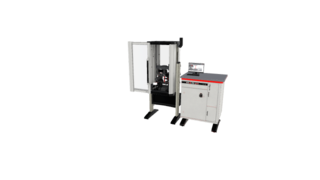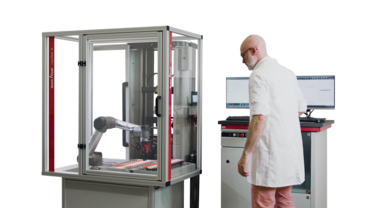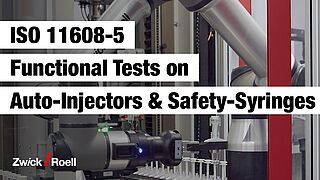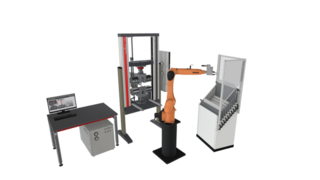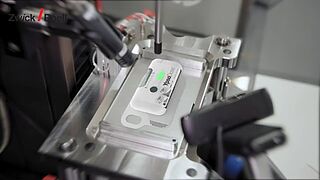ISO 11608-5 Autoinjector Testing and ISO 11608-6 OBDS Testing
The ISO 11608-5 standard specifies the requirements and test methods for automated functions in needle-based injection systems with automated functions (autoinjectors).
ISO 11608-6 specifies requirements and test methods for needle-based injection systems for use on the body (on-body-delivery systems (OBDS)).
Below you will find an overview of the ISO 11680-5 and ISO 11608-6 test methods and the autoinjector testing systems available from ZwickRoell.
With regard to large production batches, a time- and resource-saving test process is essential. Various automated ZwickRoell autoinjector testing systems are available for this purpose.
ISO 11608-5 objective ISO 11608-5 test method & autoinjector testing system Automation ISO 11608-6 objective OBDS test video Request a consultation
Overview ISO 11608
ISO 11608: “Needle-based injection systems for medical use - requirements and test methods”
- ISO 11608-1: Needle-based injection systems
- ISO 11608-2: Needles
- ISO 11608-3:Finished containers (referenced in USP 1382> and USP 382>
- ISO 11608-4: Needle-based injection systems containing electronics
- ISO 11608-5: Automated functions
- ISO 11608-6:
Objective of the autoinjector test to ISO 11608-5
An autoinjector is a medical instrument (medical device) with which liquid medication can be administered, and is therefore subject to strict quality controls. In the past, autoinjectors were mainly used when a drug needed to be administered as quickly as possible by medically untrained persons. Examples of this are adrenalin injectors used in cases of anaphylactic shock and morphine or atropine injectors used by soldiers in combat missions. Today there are two other factors that contribute to the increased use of autoinjectors.
One is injection vs. ingestion, meaning certain substances (for example, biopharmaceuticals) cannot be administered in tablet form, because they would be digested in the patient's gastrointestinal tract and would not enter the bloodstream. The other is that the autoinjector functions as an extension to the doctor's arm. Injectors guarantee a high level of application safety.
The correct injection and proper dose of medicine are vital to achieve the best therapeutic success. Therefore, pharmaceutical manufacturers strive to achieve a high level of automation in autoinjector technology. The patient simply removes the safety cap, positions the injector, and injects the drug by pressing a button. The process that follows is completely automated. However, this also means that all of the injector's relevant functions must be checked before the production batch is released on the market. This test is performed according to ISO 11608-5.
Overview of ISO 11608-5 test method and autoinjector testing system
ZwickRoell offers testing systems that can perform the following automated tests:
- Safety cap removal force in upward and downward direction
- Autoinjector activation force and travel
- Injection time measurement
- Determination of the administered drug volume, including the last drops with an integrated high-resolution scale
- Effective needle length for injection
- Safety function of the needle shield
- Testing of injectors with/without actuating button
- Color recognition on autoinjector/actuating button
- Acoustic recognition of start/end of injection
- Mistake-proofing through design (Poka-Yoke)
- Daily checks on load cell, scale, microphone, needle-length and fluid-presence sensors, as well as color recognition
- Measurement of ambient humidity and temperature
The integrated test offers the benefit that all tests can be performed on a single specimen without changing test tools. The testing system can be expanded to accommodate additional tests, satisfying a variety of market requirements and product developments. With an optional microphone to provide audible feedback, the system can detect autoinjector clicks, which indicate the start and end of the injection. In addition, an HD camera can be integrated to document liquid emission. You can save these images with the test results to support traceability. The machine can be optionally equipped with a monitoring mechanism that complies with requirements defined in the ISO 13849 standard. Our testXpert testing software manages the control and evaluation of these additional functions, as well as the entire test control sequence.
Test arrangement to ISO 11608-5 – product details
Overview of the autoinjector testing system advantages
- Multifunctional testing machine for all test sequences on one specimen
- Elimination of operator influences through sequential tests on one injector
- Five different Daily Checks guarantee reliable test results
- Testing machine for autoinjectors with and without actuating button
- Removal of injector caps in the upward and downward direction allows for tests that meet the latest standard requirements
- Injection depth and injection time measurements with innovative, camera-based methods are achieved with the highest level of accuracy
- Modular, flexible robotic system for fully automated specimen feeding
- Fast cycle times
- Validation support through expanded ZwickRoell qualification documentation (DQ/IQ/OQ)
Automated testing of autoinjectors to ISO 11608-5
When dealing with large production batches, a testing process that saves time and resources is often important. ZwickRoell offers scalable automation solutions for the medical and pharmaceutical industry covering a wide range of applications.
roboTest N: automated autoinjector testing for simple applications
The testing assistant roboTest N supports the user with simple applications. Typically, the testing of 30 autoinjectors can be automated with one magazine filling. The system can be easily and flexibly adapted to changing test requirements without requiring any special programming knowledge.
roboTest R: fully automated autoinjector testing
The fully automated robotic testing system roboTest R performs the complete test sequence from removal of the cap, through testing of the autoinjectors, to disposal of the tested specimens and good/bad sorting. To ensure reliable and comparable test results, the measuring equipment is automatically verified on a daily basis (Daily Check). Due to using several autoinjector testing systems, even a large volume of specimens is processed quickly and reliably by roboTest R.
ISO 11608-6: Testing of on-body delivery systems (OBDS) for administration of larger drug volumes
In the case of needle-based injection systems (NIS)—such as autoinjectors according to ISO 11608-5—the patient administers the respective biological drug by means of an autoinjector (bolus injection). In this form of therapy, for example for chronic diseases, the patient holds the device to the injection site until the injection is completely finished. A challenge that sometimes arises in this process: If larger volumes of a drug are administered or the injection takes longer, for example in the case of high viscosity drugs, some patients sometimes find it difficult to securely hold the portable injector in their hand.
Injection systems that are attached to the patient’s body (on-body delivery systems, OBDS) minimize possible risks that can occur when drugs are administered by conventional needle-based injection systems (NIS). In addition, the drug volume can be optimally injected in range of 2 ml to 20 ml. As a form of therapy for daily self-treatment, these on-body delivery systems, also called wearable injectors, have an adhesive surface by means of which they are applied directly and securely to the patient’s skin. The injection is administered through needles or soft cannulas.
The new ISO 11608-6 specifies the tests required for on-body delivery systems. ZwickRoell’s portfolio includes a wide range of solutions that allow you to perform these tests according to the requirements: We offer testing solutions to test the actuation force, injection time, injection volume and the needle/cannula length; in addition, our products can test optical and audible signals of these wearable injection systems. Our testing machines also allow you to measure the adhesion forces of adhesive bonding surfaces in accordance with the standards.
Video: Testing On-Body Delivery Systems According to ISO 11608-6 with ZwickRoell
Testing solutions for on-body autoinjectors determine various parameters including actuation force, injection time, injection volume, injection profile, needle length and adhesive strength of the adhesive patch. They also detect visual and audible signals before, during and after the OBDS injection. All steps take place with full standard-compliance according to ISO 11608-6, USP 905>, IEC60601-2-24 and, of course, with traceability according to FDA 21 CFR Part 11.
Interview: OBDS testing Request a consultation
Video: Ypsomed Customer Case
Ypsomed and ZwickRoell have developed an autonomous testing system for on-body-delivery-systems (OBDS). What makes it special: all necessary tests according to ISO 11608-6 are run in a single testing system.
This enables the efficient and systematic management of various attributes for OBDS in a single setup and reduces factors that influence the results.
Traceable, tamper-proof test results in accordance with FDA 21 CFR Part 11
- Ever-increasing demands are placed on software used in the medical and pharmaceutical industries to document the traceability of completed actions.
- With the traceability option, testXpert III enables logging of all actions and changes before, during and after the test, making test results and the documentation traceable and protecting them from manipulation.
- Integrated user management and functions such as electronic records and electronic signature ensure that test results are always protected from tampering.
- Together with the organizational measures and procedure instructions that apply to the individual companies themselves, the requirements of FDA in 21 CFR Part 11 are fulfilled.
- ZwickRoell also offers a qualification service package (DQ/IQ/OQ) for validation support.
- testXpert III logs all test and system related actions and settings and can therefore always answer the question “When does who do what, why and who is responsible?”
Learn more about the testXpert III
Traceability option.
